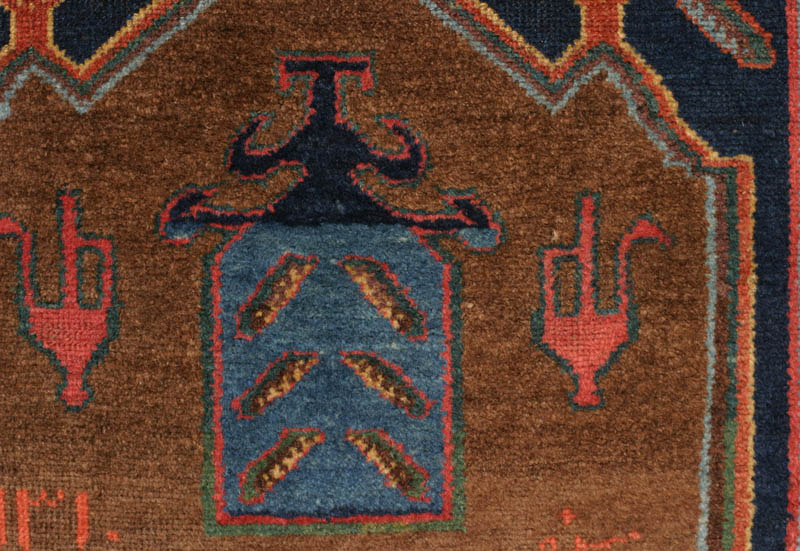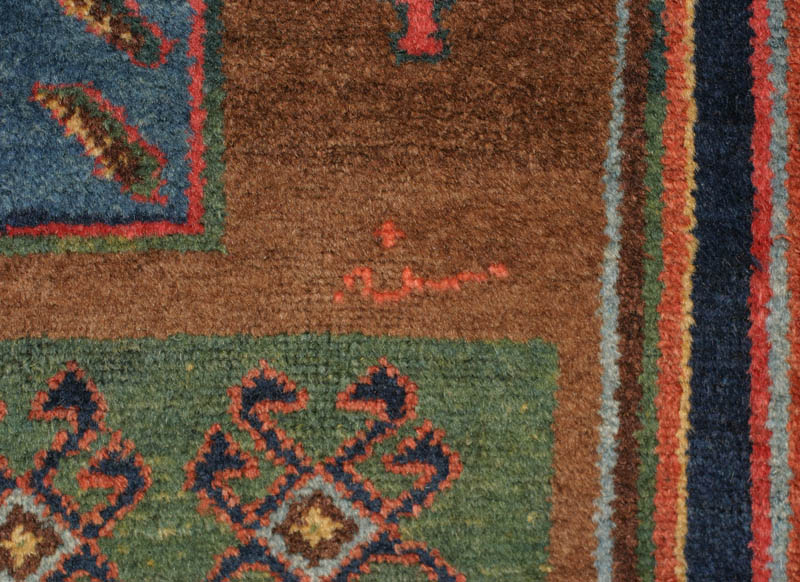The design of this type of kolyai rug has been referred to as "Takht-e-Jamshid" pattern. Presumably it represents the throne of Jamshid, a mythical King of Iran, fourth ruler of the world in the Persian legend and considered the patron of the arts and crafts (compare Ford, p.243). What seems common across the examples I have seen is the presence of two pointed elements (the throne?) that are mirrored across the central bar and flanked by altogether four oil lamps (see figure 1-A + 1-B below). In figure 1-B, the lamps are also mirrored across the horizontal axis; this creates a feeling of looking down on a hall from a bird's eye perspective. If the bar represents a table, the round elements can be read as plates, but obviously this is highly speculative.
In figure 1-A, there is a distinct flatness of rendition, emphasised by the lack of ornamentation at the sides and around the bar/table. The flatness of ground is further emphasised by the fact that it carries two inscriptions, the date al seneh 1310 [AH](the year 1892-93 AD) and presumably, a signature (I'm not sure it is one, though).
It is an interesting issue to what extent the meaning of designs is ever available to the weavers (or whether weavers construct distinctly different meanings). The lamps are fairly realistically drawn and bring a connotation of a well-lit room, but whether the two pointed elements are seats or crowns or something quite different is not easy to decide. If the pointed elements represent indeed seats or backs of seats, it looks as if King Jamshid shares the table with someone else, but this interpretation is likely to be too literal. Actually, the whole medallion, with its decorative extensions, looks like a mirrored fairy tale crown. Maybe there is a bit of design research into the origins of this motif that I am unaware of—if so, please let me know.
 |
 |
| (1-A) The Takht-e-Jamshid design in this rug is simpler and more elongated that a kolyai reference piece to the right, which is on Willborg's web site. Also, it is not red, the colour Ford (on page 243) claims to be the one uniformly used for this design. | (1-B) Willborg's counterpart is more refined and shows more definition in the central bar - is it a table seen from above? |
The four large compound elements commonly seen adjacent to the medallion, top and bottom (compare figure 1-B), are left out in our rug, the field of which is instead filled with arrays of slanted botehs or leaves, alternately leaning towards the left or the right. It seems the weaver just used the general Takht-e-Jamshid layout but had no intention to carry it through according to prescription. Maybe it just seemed a nice way of organising the field; maybe the more complex motif seen in 1-B has grown out of simpler (presumably older) versions such as this one.
The width and simplicity of the main border dominates the secondary borders, the inner one a meander widening its diagonal parts to leaves which seem to mirror the elongated botehs folling the uper and lower parts of the blue field, the outer one presenting a row of recipocal botehs in seemingly random colours, alternating with a small 'bow tie' motif. The border of the kolyai reproduced in plate 21 of Eagletons'An introduction to Kurdish rugs', here shown in fig. 2-E, is quite similar; the little 'T' shapes growing inwards from the sides equally appear, but they surround the stemless rosettes on both sides.
P.R.J. Ford speculates, in discussing a related border shown in fig. 79 in his book 'Oriental Carpet Design' which is here represented as figure 2-B, that our type of border is derived from the 'wine glass' border often used in Caucasian rugs by transforming the wineglass into a stylised peacock, presumably through a 90° rotation of the glass. This might be a mistake by Ford since the topology of the border seems so much closer to the Herati or 'samovar' border shown in his figs. 59-71, a design which alternates between rosettes flanked by curled serrated leaves and reciprocal palmettes growing inwards from a meandering stem.
 |
 |
 |
 |
| (2-A) The border of this kolyai rug | (2-B) Similar element (Ford, fig 97), here looking more like a peacock, attributed by Ford to Kakaberu | (2-C) Similar border (Edwards, fig 127) that Edwards attributes to Senjabi | (2-D) The 'peacock' motif (?) in a more recent, simpler kolyai (Ford, fig. 551) |
 |
 |
 |
 |
| (2-E) Related border in Eagleton plate 21, attributed to kolyai | (2-F) Border in a rug offered at Willborg's site (No. jpwku992), attributed to kolyai | (2-G) Some related elements in another Willborg rug (No. jpwku992) that he attributes to Kakabero | (2-H) Border showing possibly related elements in Ford, fig. 551, attributed to kolyai |
The quartered rosettes of the herati border can easily be identified in our border while they are absent in the wineglass border; the directedness of the 'peacock' motif fits the directedness of the samovars/palmettes (seen in profile) even if both bear little similarity.
The rendering of the 'peacock' in fig. 2-B looks indeed much closer to a bird shape, and with a bit of goodwill a bird can also be recognised in Edwards' example shown in 2-C. The bird topology (feet-body-neck-tail) seems however largey lost in the rest of renderings seen in fig. 2-C-2F. Should we state a loss of 'original design knowledge' in 2-A and 2-D–2-F, or are we dealing with a creative rendering of a palmette as peacock in local and narrow design tradition which was soon lost?
I have included fig. 2-G and 2-H because they contain the fork motif, which in 2-G is free-floating but in fig. 2-H can be thought of as emanating from the small box formed from the meandering vine. Topologically, the difference is that in fig. 2-H, these 'forks' (tails, shrubs, hands?) are symmetrically oriented towards the rosette while in all the other cases shown in fig 2-A–2-F, they are unidirectional, sprouting upwards.
Looking at our border in fig. 2-A without corroboration from 2-B, it is hard to decide whether the blocky element adorned with a row of colourful arrowheads and crowned with a fork indeed represents a peacock - it may just as well be a plant motif.
The rug measures 7ft.1in. x 4ft.7in. (216 x 140 cm). Off-white strongly spun Z2S wool warps, fat, strongly spun variously tan to rose brown Z3S wool wefts, single shot as in Hamadan weave, not depressed. Symmetrical knots, The weaving is coarse, the horizontal knot count is h.28/10, the vertical knot count is v.29/10, which means roughly 812 knots/dm2 (or, converted to to inches, h.7,v.7 = ca. 49 kpsi) This results in a V/H ratio of 1.03. Full and extremely meaty handle, not stiff horizontally despite the heavy wefts. No kilim ends left. Fat single cord selvage wrapped in brone wool, some parts rewrapped.
Good condition, excellent, glossy wool. Some parts of the pile in the field are lower, but mostly good to very good pile. I have hand-washed the rug, it contained much dirt and tons of sand. Structurally sound. The bottom outer guard border is sadly missing. I have removed excess material and secured the rug through whip stiching.
The rug has a beautiful all-natural palette. Three shades of madder red, one is more a brown-orange red, the other a light red or dark rose shade, finally a lighter orange red (madder overdyed with yellow?) used only for the date and the signature. Especially nice is the saturated and varied (mottled) middle green in the central bar across the medallion. There is a clear light yellow, a medium and dark indigo blue with nice abrash. The medium brown of the medallion background could be undyed brown wool, or wool that may be dyed with walnut husks. A slightly darker shade of brown is used mainly for outlining.









